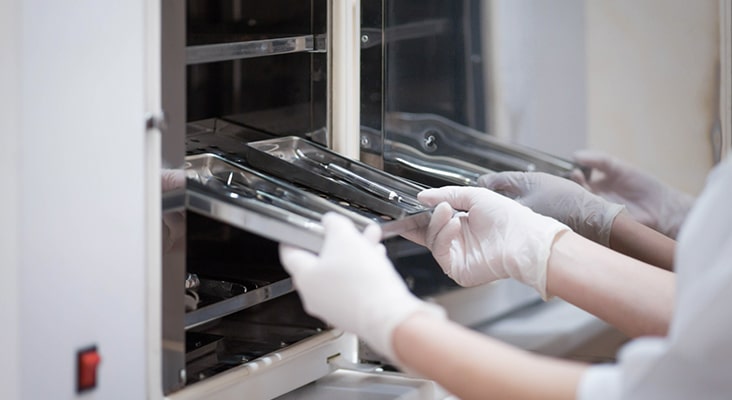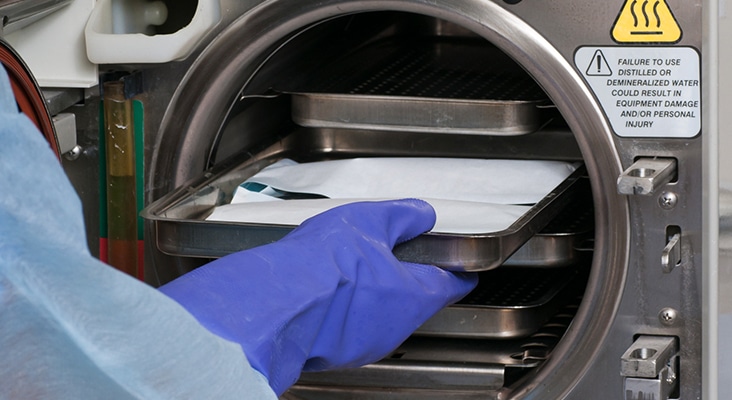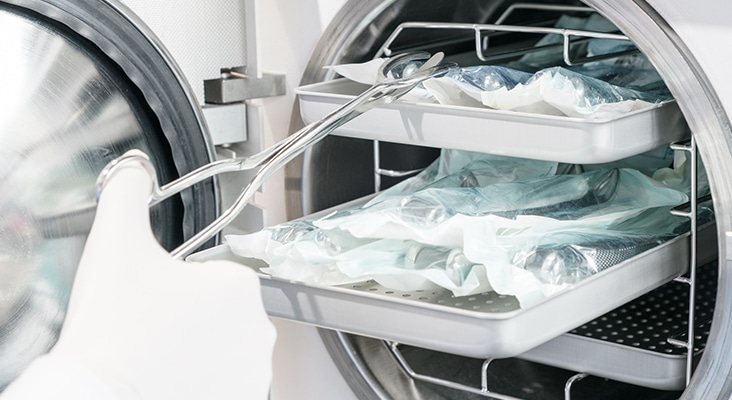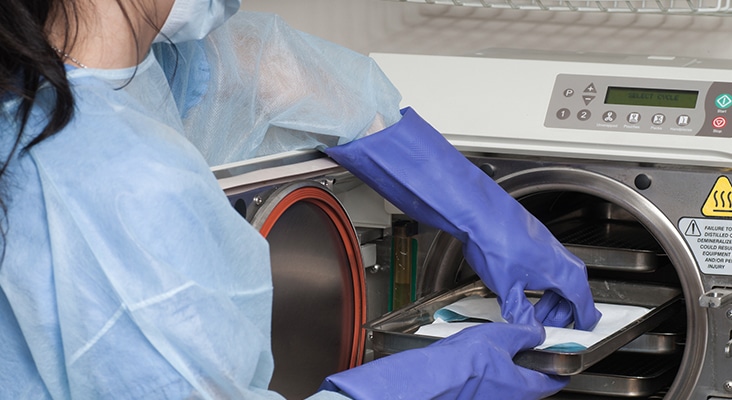Importance of Instrument Reprocessing
Cleaning and sterilization or disinfection of reusable patient care instruments and devices are crucial elements of an effective infection control protocol. Rendering dental instruments and devices safe for reuse is a multistep process that requires every step for a given device to be completed in the same sequence each time in order to ensure asepsis.

Cleaning and sterilization or disinfection of reusable patient care instruments and devices are crucial elements of an effective infection control protocol. Rendering dental instruments and devices safe for reuse is a multistep process that requires every step for a given device to be completed in the same sequence each time in order to ensure asepsis. Dental teams should also take steps to confirm—and document—that sterilization methods are successful. As part of efforts to improve outcomes in sterilization and disinfection, medical device manufacturers must now provide validated reprocessing instructions to comply with United States Food and Drug Administration requirements. Oral health professionals responsible for reprocessing should carefully read these directions for use (DFU) to ensure they have adequate equipment and materials to process the item.
Photo Credit: oneblink-cj / iStock / Getty Images Plus

Preventing Breaches
As evidenced by widespread media accounts, failure to follow validated processes and manufacturers’ DFUs for cleaning, sterilization, and disinfection may expose patients to infectious diseases. These breaches in infection control also may impact the licensees in the practice and result in a loss of confidence by patients and the public. Deviating from manufacturers’ DFUs is difficult to defend if questions arise regarding the clinic’s processes. Failure to follow established best practices and manufacturers’ instructions for reprocessing is an infection control breach.
Photo Credit: Canan turan / iStock / Getty Images Plus

Why Breaches Happen
Two common reasons for breaches include inadequate cleaning prior to sterilization of critical or semicritical devices and use of a liquid chemical disinfectant-sterilant instead of autoclaving a device that should be heat sterilized, such as dental handpieces and motors that attach and detach from dental unit air- and waterlines. The US Centers for Disease Control and Prevention (CDC) unequivocally recommends all dental handpieces and attachments connected to air- or waterlines, including motors, should be heat sterilized between patients and not surface-disinfected. If the handpiece manufacturer does not provide validated reprocessing instructions, that handpiece should not be used.
Photo Credit: Andrii Borodai / iStock / Getty Images Plus

Setting Up the Workflow
An important aspect of instrument reprocessing is to establish a workflow that minimizes the risk for a breach in protocol. The reprocessing area should be separate from patient care areas and designed with adequate space and utilities to allow separation of contaminated and sterile equipment and instruments.8 Regardless of the room layout, the equipment should be arranged to allow the following activities in a one-directional flow in this sequence:
- Collection and sorting of contaminated instruments and equipment
- Cleaning (ultrasonic, washer, or washer/disinfector), including rinsing and drying
- Packaging
- Sterilization
- Storage
Photo Credit: sujit kantakad / iStock / Getty Images Plus

Physical Monitoring
Physical or mechanical monitoring involves the use of digital displays, tapes, or other recording devices that provide information on exposure time, temperature and pressure during steam sterilization cycles. Before unloading the autoclave, oral health professionals should review the sterilization parameters to ensure the conditions required for sterilization were met. If the indicators reveal a malfunction during the sterilization process, the contents should not be released for patient use. Refer to the sterilizer DFUs to determine the appropriate steps to take after an equipment malfunction, and reprocess the items from the suspect load. The Association for the Advancement of Medical Instrumentation, which provides consensus standards for health care facility sterilization, recommends against the use of sterilizers without recording devices (with the exception of sterilizers used with accessory recording devices or printouts).
Photo Credit: leezsnow / iStock / Getty Images Plus

Chemical Monitoring
Chemical indicators are designed to assist clinicians in detecting potential sterilization failures that may be related to equipment malfunction or operator error. Even if all parameters for sterilization are met, sterilization may not be achieved if the items were incorrectly loaded in the sterilizer, or if items were placed in incorrect packaging.8 Chemical indicators change color when exposed to high temperatures, and some may react to temperature, pressure and time. A chemical indicator should be placed on the inside of every pack, and also on the outside if the internal indicator is not visible from the outside of the package. While a chemical indicator reacting to heat or time does not prove the items are sterile, it provides assurance the contents were exposed to heat in the sterilizer. Chemical indicators should be checked when removing packs from the sterilizer to ensure they have reacted to the sterilization process. If chemical indicators do not fully change color, items should not be used until they are reprocessed. Checking the chemical indicator before opening a pack of sterile instruments at the point of use will help prevent inadvertent use of unsterilized instruments.
Photo Credit: sujit kantakad / iStock / Getty Images Plus

Biological Monitoring
Biological indicators (BI), also called spore tests, are the most reliable method of monitoring the success of sterilization processes. Containing high numbers of bacterial spores that are resistant to the sterilization process, BI testing is designed to confirm sterilization lethality. The CDC recommends use of a BI test at least weekly and with each load of implantable devices. The BI should be placed in the sterilizer with the load, according to the manufacturer’s DFU. Upon removal, it should either be placed in an incubator with a control from the same lot for in-office testing, or prepared for mailing to a testing facility. If incubating the BI in the dental setting, carefully follow manufacturer’s instructions for incubation time and method of reading test results (usually a change in color and clarity of the liquid suspension).
Photo Credit: leezsnow / iStock / Getty Images Plus

Ensuring Safe Care
Regardless of the method of sterilization and disinfection, errors and breaches in instrument reprocessing may be avoided by implementing recommended policies and procedures. Providing team members who are responsible for instrument reprocessing with adequate training, appropriate equipment, and mechanisms to validate processes (such as physical, chemical, and biological monitoring) will help ensure safe care.

